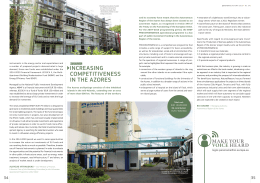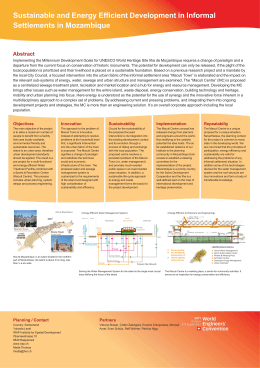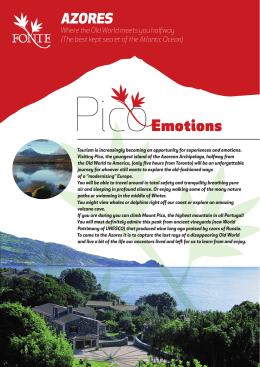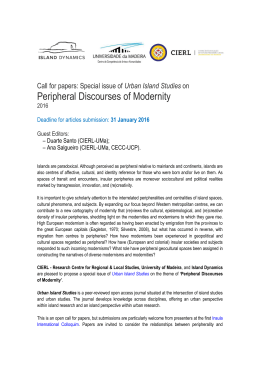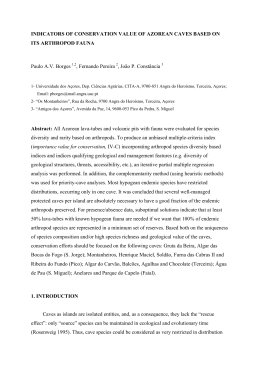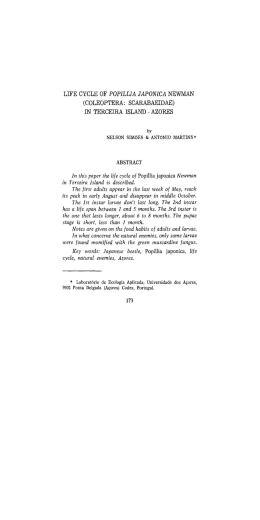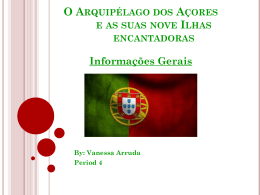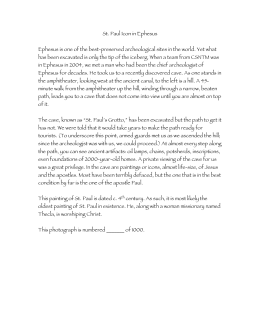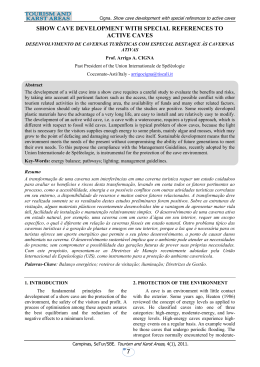XI INTERNATIONAL SYMPOSIUM ON VULCANOSPELEOLOGY AZORES - 2004 Oral Presentations SESSION I- VULCANOSPELEOLOGY OF THE AZORES ISLANDS “GRUTA DO CARVÃO” (CARVÃO CAVE) IN THE ISLAND OF S. MIGUEL (AZORES) AND ENVIRONMENTAL EDUCATION Teófilo BRAGA Amigos dos Açores, Ecological Association (Speleology Working Group), Avenida da Paz, 14, 9600-053 Pico da Pedra, S. Miguel, Azores. Email: [email protected] During the first International Meeting on Vulcanospeleology of the Atlantic Islands in 1992, the author presented a pioneer initiative for the Azores: a videotape about “Gruta do Carvão”.. Its main objectives were to provide teaching material in the field of volcanology (where there was a lack of such material) and also to promote environmental education. The present work is intended to provide a brief history of the “Amigos dos Açores” Association in publicizing the value of “Gruta do Carvão” as well as describing its activities since 1992. Main focus has been to demonstrate the importance of that volcanic cave for the purpose of environmental education, namely to create a knowledgeable public with necessary information, ability, mindsets and motivation to work to solve environmental problems. In addition to environmental workshops in various schools (primarily for grades 5 to 12) and intended to arouse environmental consciousness, between 1998 and 2003 the Association led 41 guided visits to Carvão Cave for 1,441 students. XI International Symposium on Vulcanospeleology, Azores – 2004 20 RAKING AZOREAN CAVES BASE ON MANAGEMENT INDECES João P. CONSTÂNCIA 1,5, Paulo A.V. BORGES 2,4, Manuel P. COSTA 3, João C. NUNES 2,5, Paulo BARCELOS 4 Fernando PEREIRA 4 Teófilo BRAGA 5 1- Museu Carlos Machado, Natural History Department, Convento de St. André, 9500 Ponta Delgada, S. Miguel, Azores. Email: [email protected] 2- Universidade dos Açores, Dep. Ciências Agrárias & Dep. Geociencias, Angra do Heroísmo & Ponta Delgada, Azores 3- Direcção de Serviços da Conservação da Natureza, Edificio Matos Souto, Piedade, 9930 Lajes do Pico, Pico, Azores 4- “Os Montanheiros”, Rua da Rocha, 9700 Angra do Heroísmo, Terceira, Azores 5- “Amigos dos Açores”, Avenida da Paz, 14, 9600-053 Pico da Pedra, S. Miguel, Azores The Azorean Speleological Inventory (IPEA) is a data base with information about all known Azorean volcanic caves and pits. 86 caves are known on Pico, 67 on Terceira, 27 on São Miguel, 18 on São Jorge, 11 on Graciosa, 9 on Faial, 5 on Santa Maria, and 2 on Flores (Fig. 1). About 60 of these 225 caves have been mapped, with a total of 41,122 m of passages. About 71% are lava tube caves, 10% are pits, 7% are erosional caves, 4% are crevice caves and the others are multiprocess or undetermined types. To date, about 65% of these caves are unsatisfactorily studied, in particular its biological and geological features. São Miguel 12% Santa Maria 2% Pico 38% Corvo 0% Terceira 30% Faial 4% Flores 1% Graciosa São Jorge 5% 8% Fig. 1. Distribution of volcanic caves in the Azores (total = 225). IPEA includes a classifying system which relies on objective sets of criteria which yield logical, coherent and reliable results. Its multi-criteria sets also can provide complex classifications which can be used as managing tools. IPEA incorporates six major XI International Symposium on Vulcanospeleology, Azores – 2004 21 classification topics: scientific value, potential for tourism, access, surrounding threats, available information and conservation status. Each topic is assigned by an index (from I to V), based on weighted factors for biological components, geological features, accessibility, singularity and beauty, safety, caving progress, threats, integrity, and available information. Each factor was quantified from 0 (zero) to 5. Lack of information is quantified as zero and the other figures (1 to 5) are objective statements that describe the cave characteristics within the factor. An initial analysis based on a multi-criterion approach yielded the following (Table): 1- using positive weighting for geological features, biological components, singularity and beauty, available information, and integrity, 15 caves were found to have especially high scientific values; 2- using positive weighting for geological features, accessibility, singularity and beauty, safety, caving progress, available information, and integrity, and a negative weighting for biological components, 13 caves were found to have great touristic potential; 3- using positive weighting for geological features, biological components, available information, threats, and integrity, 7 caves were found to merit high conservation status. Table. Ranking most significant Azorean caves, accordingly to three classification issues. SCIENTIFIC VALUE TOURISTIC POTENTIAL CONSERVATION Água de Pau S. Miguel Island Agulhas Terceira Island Algar do Carvão Terceira Island Balcões Terceira Island Cabras II Pico Island Canárias Pico Island Chocolate Terceira Island Frei Matias Pico Island Furna do Enxofre Graciosa Island Henrique Maciel Pico Island Montanheiros Pico Island Natal Terceira Island Ribeira do Fundo Pico Island Soldão Pico Island Torres Pico Island Agulhas Terceira Island Algar do Carvão Terceira Island Branca Opala Terceira Island Carvão S. Miguel Island D’Água Terceira Island Furna do Enxofre Graciosa Island João do Rego S. Miguel Island Montanheiros Pico Island Natal Terceira Island Ribeira do Fundo Pico Island Santana Santa Maria Island Torres Pico Island Túmulos Pico Island Água de Pau S. Miguel Island Agulhas Terceira Island Algar do Carvão Terceira Island Cabras II Pico Island Chocolate Terceira Island Furna do Enxofre Graciosa Island Montanheiros Pico Island XI International Symposium on Vulcanospeleology, Azores – 2004 22 ALGAR DO CARVÃO VOLCANIC PIT, TERCEIRA ISLAND (AZORES): GEOLOGY AND VOLCANOLOGY Victor H. FORJAZ 1, João C. NUNES 1, Paulo BARCELOS2 1- Universidade dos Açores, Departamento Geociências, Rua Mãe de Deus, 9501-801 Ponta Delgada, Azores. Email: [email protected] 2- “Os Montanheiros”, Rua da Rocha, 9700 Angra do Heroísmo, Terceira, Azores The Algar do Carvão pit is an impressive volcanic conduit located in the Basaltic Fissural Area, in central Terceira island. Initially it was included in a Geologic Natural Reserve (Regional Legislative Decree nr. 13/87/A, of July 21). Recently it was reclassified as a Regional Natural Monument due to unique volcanic features and additional ecological and conservation importance. Among this features are siliceous speleothems (stalactites and stalagmites of amorphous silica), refusion walls, obsidian dripstones, a lake, vegetation around the vent and along the pit walls, and a troglobitic fauna. In general terms, the pit had a two-phase genesis. It partially corresponds to the volcanic conduit of a scoria cone previously dated at 2,115 years BP. Also a significant part of Algar do Carvão is developed on older trachytic domes and/or coulées related to the silicic polygenetic volcano of Pico Alto. 14 C age determinations in charcoal trunks collected near the lake level and on trachytic formations inside the Algar do Carvão gave ages of 3,200 ± 40 years BP. Similar radiometric dating analysis on charcoal found beneath the basaltic lava flow of Algar do Carvão gave ages of 1730 ± 40 years BP for that lava flow. The site of the latter 14C sample was close to the main road and outside the pit. It also should be emphasised that another 14C analysis done on a Pico Alto Volcano pumice deposit, NE of Algar do Carvão’s scoria cone gave an age of 2,610 ± 70 years BP. Together with field studies done in the area and in the pit, these age determinations allowed us to conclude that Algar do Carvão initially formed in trachytic flows about 3,200 years ago. Subsequently, other silicic eruptions occurred on the Pico Alto volcanic centre, with extrusion of lava flows and pumice, one of which occurred about 2,600 years ago. More recently (about 1,700 to 2,100 years ago), several (?) basaltic eruptions occurred in the area with extrusion of flooding lava flows. Along last days of one of these basaltic eruptions, and due to tectonic stress, the very fluid lava retreated inside the conduit of the scoria cone and allowed the formation of Algar do Carvão pit as it exists today. XI International Symposium on Vulcanospeleology, Azores – 2004 23 THE PROJECT FOR THE VISITORS CENTER BUILDING OF THE GRUTA DAS TORRES VOLCANIC CAVE, PICO ISLAND, AZORES Inês VIEIRA da SILVA, Miguel VIEIRA Direcção Regional do Ambiente, Rua Cônsul Dabney, Colónia Alemã, Apartado 140, 9901 Horta, Faial, Azores. Email: [email protected] Gruta das Torres is a notable volcanic cave in the parish of Criação Velha, municipality of Madalena on the island of Pico in an agricultural landscape. This paper presents the project for a Visitors Center building for this cave (Table) developed from two primary standpoints: 1) to enclose the access skylight to control the entrances and provide security; 2) to provide support and information services to the visitor. To response simultaneously to these two standpoints, a stone wall 1.80 meters high is planned to surround the skylight entrance and at the same time to allow the drawing of the building to emerge from it. Outside the building, will be a small courtyard with a reflecting pool. Visitors will be able to buy entry tickets and wait for the guided tour in a Waiting Room, then proceed to an Auditorium for a briefing. Helmets, electric hand lamps and other necessary equipment will be available in the Auditorium. Entry into the cave will be by a stairway already built with local pahoehoe slabs. It will continue inside the cave where an overpass 40 m long will allow visitors to avoid existing breakdowns, without the need to remove this debris. Tours will be about 400 m long, 200 m in each direction. After each tour, visitors will returns to the Waiting Room, through the same stairway and by way of a ramp which bypasses the Auditorium. Thus, several groups of visitors can tour the cave simultaneously without crossing each other. The building’s structure will consist of reinforced concrete, built on a rail, also of reinforced concrete. This solution avoids the use of foundations, believed to cause excessive vibrations in the surrounding area and also being subject to puncture. The Visitors Center building is continuous with the stone wall protecting the skylight, not only because both elements were created from a single formal gesture, but because different techniques for emplacement of the local materials will be used. Thus, the wall will consist of stone mortar and the whole south facade of the building will be made in stone and employing the local construction technique known as “currais de figueiras”. The latter allows light to enter all along the wall of the building. The remaining facades will be covered by a black waterproof surface that resembles the texture of the glassy lava in the cave. Vegetation in the area is most impressive on the edge of the skylight and just inside. Thus, the building and the wall around the skylight just reinforce the whole ensemble, incorporating this vegetation into an architectural unit within an agricultural landscape. Even bearing in mind that the building is itself a constructed architectonic volume. XI International Symposium on Vulcanospeleology, Azores – 2004 24 Table. Main characteristics of the project. Name Visitors Center of the “Gruta das Torres” volcanic cave Location Criação Velha, Madalena, Pico Island, Azores Client Direcção Regional do Ambiente - Secretaria Regional do Ambiente Architects Inês Vieira da Silva, Miguel Vieira Structural Engineer Rui Borges Pereira Electrical Engineer Projectangra - Helena Vargas XI International Symposium on Vulcanospeleology, Azores – 2004 25
Download
